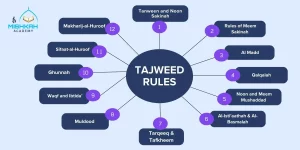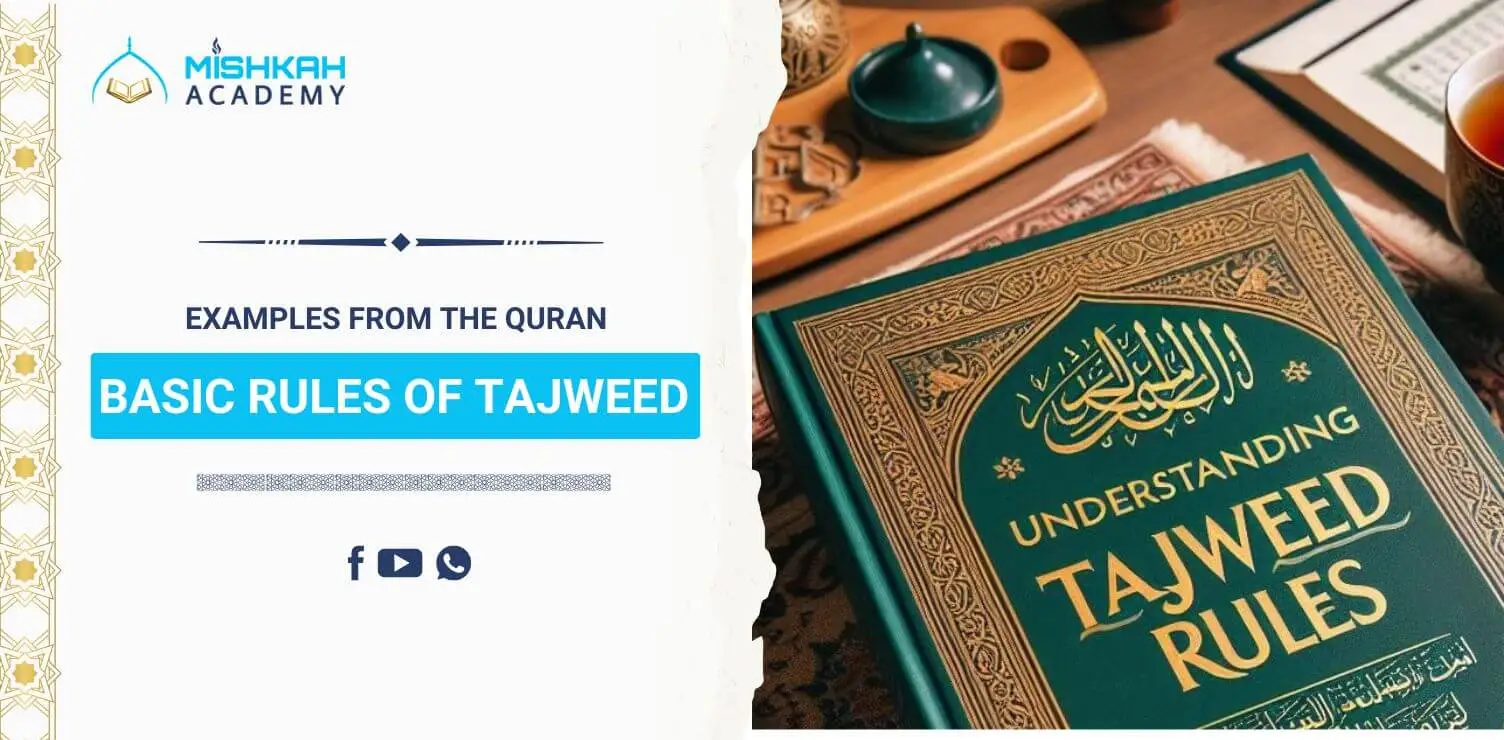The recitation of the Quran is very important to Muslims worldwide. Reading Allah’s teachings is more than just a spiritual connection; it is also a way to seek direction and consolation. The science of Tajweed is essential for the correct Quran recital. Tajweed is a collection of norms and principles for perfect pronunciation, articulation, and beautiful recitation of the Quran.
What are Tajweed Rules?
Table of Contents
ToggleTajweed Rules are the proper recitation of the Quran, following a set of rules and principles to ensure the correct pronunciation and articulation of the Arabic text. Tajweed is derived from the Arabic word “Jawwada,” meaning “to make good” or “to improve.” It ensures that the Quranic text is recited with the correct articulation, intonation, and emphasis, preserving the original Arabic phonetics and preserving the intended meaning
12 Rules of Tajweed With Examples from the Quran

Today, we will share 12 Tajweed rules that will beautify your Quran recitation and make reading the Quran easier than ever!
1. Tanween and Noon Sakinah
One of the main topics that form a large part of Tajweed is the rules of Noon Sakeen and Tanween. Let’s first start with their meaning and then learn the Tajweed rules with examples of all their types.
Tanween: It is called nunation when Tanween gives the sound of “an” at the end of the word with fatha, “un” at the end of the word with damma, and “in” at the end of the word with kasra.
Example:
As for Noon Sakeen: It is called Noon with Jazm without movement (Harakah). Tanween and Noon Sakeen are read in one of the forms Ikhfaa, Izhaar, Idgham, and Iqlaab according to the letters that follow them.
1- Izhaar (making clear)
If one of the 6 letters with throat letters (Huruf Halqiyyah) comes after Tanween or Noon Sakeen, it is called tanween or noon Sakeen to be read clearly without idgham, Iqlab and Ikhfaa. The Huruf Halqiyyah are: khaa’ (خ), ghayn (غ), haa’ (ح), ayn (ع), haa (هـ), and hamzah (ء). Example:
2- Idghaam (merging)
It means joining a non-vowel with a vowel so that the two letters become one letter of the second type. As for the meaning of Ghunnah, it is the sound coming from the mouth and nasal cavities for 2 beats.
- A) Idgham Bila (without) Ghunnah
If the Quranic letters Lam or Ra come after tanween or sakeen noon, idgham without ghunnah occurs. Examples for Idgham without Ghunnah
- b) Idgham Ma’al (with) Ghunnah :
It occurs when one of the letters with Ghunnah (ي – ن – م – و) comes after Tanween or noon Sakeen (in separate words). Example of Idgham with Ghunnah
3- Iqlaab (converting)
When the letter ba comes after tanween or sakeen noon, it is called turning tanween or noon into a meem letter whilst adding Ghunnah of 2 beats.
4- Ikhfaa (hiding)
If one of the letters of Ikhfaa comes after tanween or noon Sakeen, the Ikhfaa rule appears. It is called not speaking the noon sakeen openly, but hiding or adding a blurry Noon sound with Ghunnah.
Letters of Ikhfaa’ are (ت، ث، ج، د، ذ، ز، س، ش، ص، ض، ط، ظ، ف، ق، ك). or we can simply say: any letter other than the letters of Izhaar, Iqlaab or Idghaam.
2. Rules of Meem Sakinah
Now the rules of noon Sakinah and Tanween are clear. But what are the Meem sakeen rules? Let’s take a look!
1- Ikhfaa Shafawy
It happens when a letter ba with movement comes after meem sakeen. Example:
2- Idghaam Mutamathelyne Sagheer
If a meem with movement (fatha, damma, or kasra) comes after a meem with no Harakah, this rule occurs.
3- Izhaar Shafawy
It occurs when any letters other than Meem and Baa come after the meem with no Harakah.
3. Al Madd
Another basic tajweed rule that should definitely be known is the Madd. The letters of Madd are letters without movement (Harakah) ى و ا. Madd letters allow the letters in front of them to be read by being stretched for a duration of different amounts such as two, four, or six beats.
1- Two Beat Madd
Two-beat Madd is also called natural Madd. In other words, the Madd (elongation) feature is due to the letter itself. It is not based on any subsequent reason such as hamza or Sukoon and its duration is two beats.
Examples: When a letter with fatha comes before “alif” ( ا ) without a vowel, the letter before is read stretched:
2- Two, Four or Six Beat Madd (the flexible)
If one is to stop on a word and there is Madd before the last letter, then one may pause by extending for four beats or 6 beats with a minimum duration of two beats. Example:
3- Four Beat Madd
If Madd is in the middle of a word and is followed by hamza, it should be prolonged to four beats. Example:
Another similar four-beat prolongation case is if a word ends with Madd and the other word starts with hamza, the madd letter is also prolonged in the same way. Example:
4- Six Beat Madd
If a Madd letter is followed by a Shaddah letter, the Madd letter should be prolonged to 6 beats. Example:
4. Qalqalah
Qalqalah in tajweed means echoing the Makhraj so that a strong sound is heard. If one of the Qalqalah letters is found without Harakah in the middle of the word, a quick echo should be given. Also, when the Qalqalah letter is at the end of the word, Qalqalah should be pronounced a bit stronger.
What are the Qalqalah letters? Well, they can be collected in the words (قُطْبُ جَدٍ), or (ق – ط – ب – ج – د) With this coding, it will be easier for you to remember the letters of Qalqalah.
5. Noon and Meem Mushaddad
If one of the letters noon or meem has a Shaddah sign, two-beat Ghunnah is applied during the recitation. One point should be noted that even if a pause is made on that letter, two-beat Ghunnah is still pronounced.
6. Al-Isti’aathah (الاستعاذة) & Al-Basmalah (البسملة)
Al-Isti’aathah (الاستعاذة)
Al-Isti’aathah, meaning “Seeking Refuge,” involves saying the phrase “A’udhu billahi min ash-shaytan ir-rajim” before you start reading the Quran. In English, this means “I seek refuge in Allah from the accursed devil.” This practice is important because it asks Allah to protect you from any distractions or negative influences while you engage with the holy text. By reciting Al-Isti’aathah, you are spiritually preparing yourself to focus and seek Allah’s help in understanding and reciting the Quran correctly.
Al-Basmalah (البسملة)
Al-Basmalah consists of the phrase “Bismillah al-Rahman al-Rahim”, which translates to “In the name of Allah, the Most Gracious, the Most Merciful.” This phrase is recited at the beginning of most chapters (Surahs) in the Quran. It serves as an invocation, seeking Allah’s blessings and mercy as you begin to recite His words.
Rules of Al-Isti’aathah and Al-Basmalah
1. Single Recitation for the Entire Quran:
You only need to say “Seeking Refuge” once for the whole Quran. However, it is better to say it at the start of each Surah for added protection and focus.
2. Starting Each Surah with Basmalah:
Begin every Surah with “In the name of Allah” (Basmalah), except for Surah Al-Tawbah.
3. Optional Basmalah Within a Surah:
Inside a Surah, saying Basmalah is optional, but it is recommended to include it for better clarity and flow.
4. Combining Al-Isti’aathah with Basmalah:
When starting a Surah, you can say “Seeking Refuge” together with Basmalah to enhance your spiritual preparation.
5. Basmalah Between Surahs:
Between two Surahs, you can either connect Basmalah with the previous Surah or leave it out, but you should not do both.
6. Exception for Surah Al-Tawbah:
Surah Al-Tawbah does not begin with Basmalah. Instead, reciting “Seeking Refuge” alone is sufficient before starting this Surah.
Note: Mishkah Academy teaches all tajweed rules properly in the online tajweed course to start understanding and reciting the Quran beautifully.
7. Tarqeeq & Tafkheem (تَفْخِيم)
Tafkheem means “Emphasizing” certain letters in Arabic to make them sound heavier and more pronounced during Quranic recitation. This rule adds depth and richness to the recitation, highlighting the importance of specific words and letters.
Definition:
Tafkheem involves strengthening the pronunciation of heavy letters, known as Mufakhkham. These letters require a more forceful articulation, making them resonate more in your mouth.
Rules:
- Heavy letters must be pronounced with greater emphasis.
- The sound should fill your mouth, creating a fuller and more resonant echo.
Examples:
- Taa (الطاء): In the word “تَقْطِيعٌ” (cutting), the letter Taa is pronounced forcefully.
- Qaaf (القاف): In the word “قَوْمٌ” (a people), the Qaaf is emphasized to highlight its importance.
Tarqeeq (تَرْقِيق)
Tarqeeq is the opposite of Tafkheem and means “Lightening” the pronunciation of certain letters to make them sound softer and less emphasized during recitation.
Definition:
Tarqeeq involves softening the pronunciation of light letters, known as Muraqqaq. These letters are articulated with less emphasis, creating a gentler tone in the recitation.
Rules:
- Light letters should be pronounced softly without adding extra emphasis.
- This creates a smoother and more flowing recitation, contrasting with the heavy letters emphasized in Tafkheem.
Examples:
- Seen (السين): In the word “سُرُورًا” (joy), the Seen is pronounced softly.
- Ha (الهاء): In the word “هُدًى” (guidance), the Ha is articulated gently to convey its softness.
Letters with Variable Emphasis
Some letters can be pronounced with either Tafkheem or Tarqeeq depending on the context. These include Alif (ا), Lam (ل), and Ra (ر).
- Alif (ا): Its heaviness changes based on the letter before it. It is heavy after a heavy letter and light after a light one.
- Lam (ل): Pronounced heavy when followed by a Dumma (ُ) or Fatha (َ), and light when followed by a Kasra (ِ).
- Ra (ر): Generally has a moderate emphasis but becomes slightly heavier if preceded by a Fatha (َ).
8. Muldood (مُلْدُود)
Muldood refers to the elongation of specific vowels in Arabic pronunciation, particularly the letters Alif (ا), Ya (ي), and Waw (و). This elongation is marked by a symbol called Maddah placed above the letter, indicating that the vowel should be held longer during recitation.
Definition:
Muldood involves stretching certain vowel sounds to enhance the melodic flow of the Quranic recitation.
Example from the Quran:
In Surah Al-Muzzammil (73:4), Allah instructs the Prophet Muhammad (peace be upon him) with the verse:
“أَوْ زِدْ عَلَيْهِ وَرَتِّلِ الْقُرْآنَ تَرْتِيلًا” (Or add to it, and recite the Quran with measured recitation).
In the word “تَرْتِيلًا” (with measured recitation), the Ya (ي) is elongated with a Maddah symbol (ٓ) above it. This elongation ensures the word is recited smoothly and melodiously.
9. Waqf (وَقْف) and Ibtida’ (اِبْتِدَاء)
Waqf and Ibtida’ are essential rules in Tajweed that guide where and how to pause or start during Quranic recitation. Understanding these rules helps maintain the flow and meaning of the verses.
Waqf (Pausing)
Waqf means knowing when to pause while reciting the Quran. Proper pauses help in understanding the meaning and ensure that the recitation flows naturally without abrupt stops.
Example from the Quran:
In Surah Al-Fatiha (1:1-2), the phrase:
“بِسْمِ اللَّهِ الرَّحْمَٰنِ الرَّحِيمِ” (In the name of Allah, the Most Gracious, the Most Merciful)
marks the starting point of the chapter. It is customary to make a brief pause after reciting this phrase, signifying the beginning of recitation with Allah’s name before moving on to the rest of the Surah.
Ibtida’ (Starting)
Ibtida’ dictates where to begin your recitation. It ensures that you start at the correct point in the text, maintaining the continuity and integrity of the Quranic verses.
Example from the Quran:
Using the same verse from Surah Al-Fatiha (1:1-2), the recitation begins with Ibtida’ at “بِسْمِ اللَّهِ”, setting the stage for the rest of the Surah.
10. Ghunnah (غُنَّة)
Ghunnah is a Tajweed rule that adds a nasal sound when certain Arabic letters are followed by specific nasal letters. This rule enhances the musical quality of Quranic recitation and ensures precise pronunciation.
Definition:
Ghunnah involves a subtle nasal vibration produced when specific letters are pronounced, making the recitation more melodious and accurate.
Example from the Quran:
In Surah Al-Fil (105:5), Allah describes the fate of the people of the elephant with the verse:
“فَجَعَلَهُمْ كَعَصْفٍ مَّأْكُولٍ” (So He made them like eaten straw).
Here, in the word “مَّأْكُولٍ” (ma’koolin), the Meem Sakinah (مْ) is followed by another Meem, resulting in Ghunnah. This combination produces a nasal sound, making the pronunciation smooth and harmonious. Moreover, enroll in an advance tajweed course to learn meem ghunnah rules properly with Quranic examples.
11. Sifaat-al-Huroof (صفات الحروف)
Sifaat-al-Huroof, or Attributes of Letters, are the unique characteristics of Arabic letters that affect their pronunciation during Quranic recitation. Understanding these attributes helps in articulating each letter correctly, ensuring clear and precise recitation.
Two Types of Sifaat-al-Huroof
- Sifaat Mutadaaddah (صفات متعدّدة) – Continuous Attributes
These are the characteristics of letters that allow for a continuous flow of breath without interruption during pronunciation. These letters, known as whisperers, help maintain a smooth and uninterrupted recitation.
Examples:
- Fa (فَ): In the word “فَ”, pronounced smoothly without stopping the breath.
- Ha (حَ): In “حَ”, articulated softly, facilitating continuous flow.
- Sheen (شَ): In “شَ”, pronounced gently to maintain breath flow.
- Sifaat Ghayr Mutadaaddah (صفات غير متعدّدة) – Discontinuous Attributes
These are the characteristics of letters that discontinue the breath during pronunciation, creating a distinct break or emphasis. These letters are known as majhoorah and require clear articulation with a vibration from the vocal cords.
Examples:
- Ain (ع): In the word “عَلَىٰ”, pronounced with a clear vocal vibration.
- Dha (ظ): In “الضَّرُورِيَّةِ”, articulated firmly to create emphasis.
- Ghain (غ): In “غَفُورٌ”, pronounced with a strong vocal emphasis.
12. Makharij-al-Huroof (مخارج الحروف)
Makharij-al-Huroof, meaning “Points of Articulation”, refers to the specific places in the mouth and throat where each Arabic letter is pronounced. Proper understanding of Makharij-al-Huroof is crucial for accurate and clear Quranic recitation.
Importance:
Each Arabic letter has a unique origin point in the mouth or throat. Correctly identifying and using these points ensures that each letter is pronounced as intended, preserving the meaning and beauty of the Quranic text.
Examples from the Quran:
- Surah Al-Baqarah (2:7):
- Word: “قلب” (qalb) meaning “heart”.
- Letters:
- Qaf (ق): Pronounced from the back of the throat.
- Lam (ل): Articulated from the tip of the tongue.
- Impact: The distinct points of articulation for Qaf and Lam ensure clear pronunciation and proper meaning.
- Surah Al-Falaq (113:5):
- Word: “الْفَلَقِ” (al-falaq) meaning “Daybreak”.
- Letter: Qaf (ق)
- Origin: Pronounced from Al-Jawf, the hollow part of the throat.
- Impact: Correct pronunciation from this area maintains the integrity and melodiousness of the recitation.
Types of Makharij-al-Huroof
- Al-Jawf (الجوف) – The Hollow of the Throat:
- Description: The deep part within the throat.
- Letters:
- Alef (ا)
- Hamzah (ء)
- Example: In “أَبْ” (father), Alef is pronounced from Al-Jawf.
- Al-Halq (الحلق) – The Throat:
- Description: The part of the throat where sounds are produced.
- Letters:
- Ha (ح)
- Ain (ع)
- Ghain (غ)
- Example: In “حَمْدٌ” (praise), Ha is pronounced from Al-Halq.
- Al-Lisaan (اللسان) – The Tongue:
- Description: Involves different parts of the tongue.
- Letters:
- Qaf (ق)
- Kaf (ك)
- Noon (ن)
- Example: In “قَلْبٌ” (heart), Qaf is pronounced from the back of the tongue.
- Ash-Shafataan (الشفتان) – The Lips:
- Description: Involves the movement and placement of the lips.
- Letters:
- Ba (ب)
- Meem (م)
- Waw (و)
- Example: In “بِسْمِ” (in the name), Ba is pronounced by bringing the lips together.
- Al-Khayshoom (الخيشوم) – The Nasal Cavity:
- Description: Involves sounds produced through the nose.
- Letters:
- Noon (ن) when accompanied by Tanween (ًٌٍ)
- Meem (م) when accompanied by Shaddah (ّ)
- Example: In “مُنَّافِقُونَ”
Conclusion
Learning the rules of Tajweed is essential for accurate and beautiful Quran recitation. For those looking to deepen their recitation skills, Mishkah Academy is the best source to learn Tajweed in their tajweed rules course. Their expert tutors, with years of experience, can guide students from the UK, USA, Canada, Australia, Germany, and across Europe step-by-step, making the learning process easier and more effective. With the right guidance and practice, anyone can improve their recitation and truly appreciate the beauty of the Quran.






